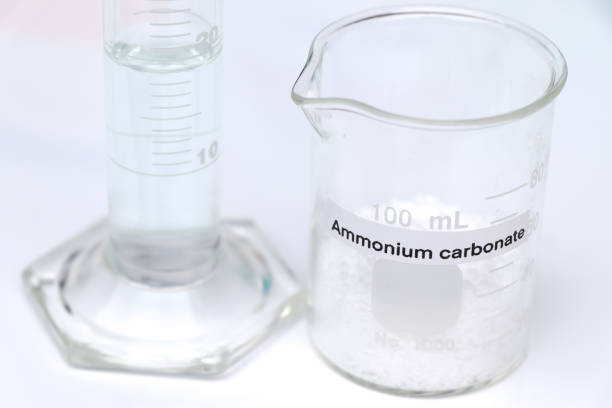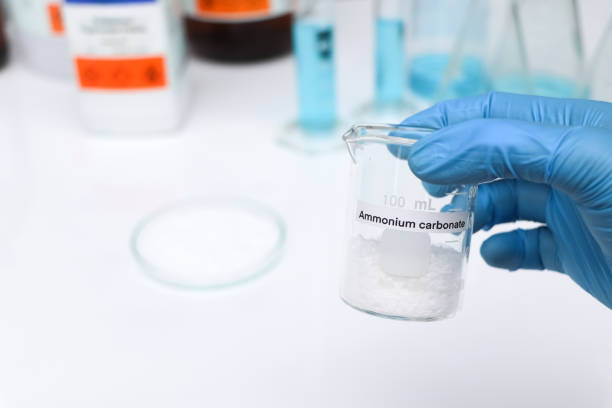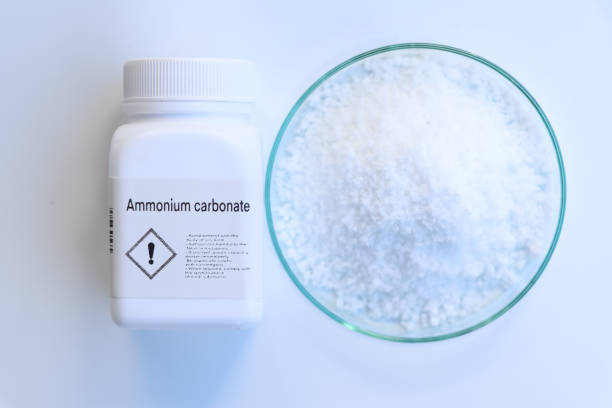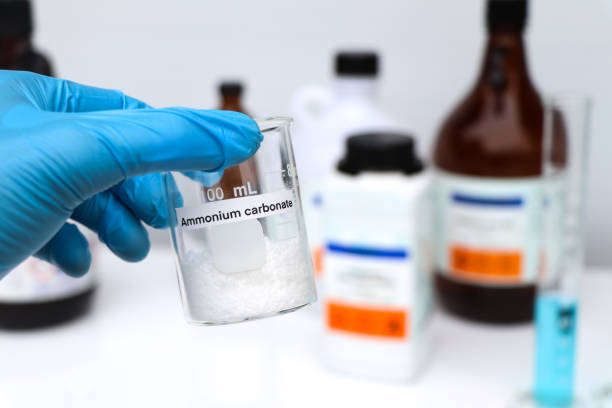Ammonium carbonate is a vital chemical compound with widespread applications across food, pharmaceuticals, agriculture, and laboratories. Known for its versatility and unique properties, this compound has been used for centuries, especially in baking and industrial processes. In this complete guide, we will explore its structure, preparation, uses, benefits, and safety considerations in detail.
Introduction to Ammonium Carbonate
Ammonium carbonate, with the chemical formula (NH₄)₂CO₃, is a white crystalline compound made up of ammonium and carbonate ions. It readily dissolves in water and is widely recognized for its use as a leavening agent in baking, traditionally known as “baker’s ammonia.”
When exposed to air, ammonium carbonate decomposes, releasing ammonia (NH₃), carbon dioxide (CO₂), and water vapor, making it useful in several chemical processes.
Chemical Structure and Formula
- Formula: (NH₄)₂CO₃
- Molar Mass: 96.09 g/mol
- Appearance: White crystalline powder or lumps
- Odor: Strong ammonia-like smell
- Solubility: Soluble in water, but decomposes on prolonged exposure to air
The compound consists of two ammonium (NH₄⁺) cations and one carbonate (CO₃²⁻) anion, giving it both alkaline and volatile characteristics.
How is Ammonium Carbonate Prepared?

Ammonium carbonate is generally synthesized through the reaction of ammonia gas with carbon dioxide in an aqueous environment.
2NH₃ + H₂O + CO₂ → (NH₄)₂CO₃
It can also be obtained as a commercial mixture containing ammonium bicarbonate (NH₄HCO₃) and ammonium carbamate (NH₂COONH₄), both of which decompose easily into ammonia and carbon dioxide.
Physical and Chemical Properties
- Physical Properties
- White crystalline powder.
- Hygroscopic (absorbs moisture easily).
- Soluble in water but insoluble in alcohol.
- Decomposes at room temperature when exposed to air.
- Chemical Properties
- Decomposes on heating:
(NH₄)₂CO₃ → 2NH₃ + CO₂ + H₂O - Functions as a weak base because of the presence of ammonium ions.
- It reacts with acids to release CO₂
- Decomposes on heating:
Uses of Ammonium Carbonate
Ammonium carbonate is widely used in various industries due to its decomposing ability and alkaline nature.
1. Food Industry
- Historically used as baker’s ammonia in biscuits, cookies, and crackers.
- Acts as a leavening agent, releasing gases that make baked goods light and porous.
- Unlike modern baking powder, it leaves no salty taste but produces ammonia odor, which dissipates during baking.
2. Pharmaceutical Industry

- Used as an expectorant in cough medicines to stimulate mucus production.
- Incorporated into smelling salts due to its ability to release ammonia vapors that revive consciousness.
3. Agriculture
- Applied as a fertilizer additive due to its nitrogen content.
- Sometimes used in pesticide formulations.
4. Chemical Industry
- Functions as a pH regulator in various chemical processes.
- Used in the production of fire extinguishing compounds.
- Applied in laboratories for analytical purposes.
5. Other Uses
- Employed in the textile and dyeing industries.
- Utilized in cleaning agents and detergents.
Benefits of Ammonium Carbonate
- Effective Leavening Agent: Provides fluffiness in baked goods without leaving residues.
- Medicinal Value: Helps relieve cough by loosening mucus.
- Laboratory Applications: Useful for experiments requiring controlled release of gases.
- Cost-Effective: Readily available and inexpensive compared to other alternatives.
Health and Safety Considerations
While ammonium carbonate is generally safe when used properly, handling requires caution.
- Inhalation Risks: The strong ammonia fumes may irritate the respiratory system.
- Skin Contact: May cause mild irritation; gloves should be worn.
- Ingestion: Safe in small food-grade amounts, but excessive consumption can cause gastrointestinal issues.
- Storage: It should be kept in airtight containers to prevent decomposition.
Environmental Impact
Ammonium carbonate decomposes naturally into ammonia, carbon dioxide, and water vapor. While ammonia release can contribute to air pollution in large amounts, controlled usage minimizes environmental risks. It does not pose significant hazards when used in regulated industries.
Comparison with Baking Powder and Baking Soda

- Baking Soda (NaHCO₃): Produces carbon dioxide only when combined with acids.
- Baking Powder: A mixture of baking soda and acid salts for consistent leavening.
- Ammonium Carbonate: Decomposes on heating, producing carbon dioxide and ammonia, effective in thin baked goods where gases can escape easily.
This makes ammonium carbonate preferable for flat, dry baked items but unsuitable for moist or thick products where ammonia odor may remain.
Conclusion
Ammonium carbonate is a versatile compound with significant roles in the food, pharmaceutical, agricultural, and chemical industries. From its historic use as baker’s ammonia to modern applications in medicines and fertilizers, it continues to be an essential chemical in everyday life. Proper handling, storage, and application ensure maximum benefits while minimizing risks.
What is ammonium carbonate used for?
Ammonium carbonate, with the chemical formula (NH₄)₂CO₃, is a white crystalline compound made up of ammonium and carbonate ions. It readily dissolves in water and is widely recognized for its use as a leavening agent in baking, traditionally known as “baker’s ammonia.”
When exposed to air, ammonium carbonate decomposes, releasing ammonia (NH₃), carbon dioxide (CO₂), and water vapor, making it useful in several chemical processes.
Chemical Structure and Formula
Formula: (NH₄)₂CO₃
Molar Mass: 96.09 g/mol
Appearance: White crystalline powder or lumps
Odor: Strong ammonia-like smell
Solubility: Soluble in water, but decomposes on prolonged exposure to air
The compound consists of two ammonium (NH₄⁺) cations and one carbonate (CO₃²⁻) anion, giving it both alkaline and volatile characteristics.
How is Ammonium Carbonate Prepared?
Ammonium carbonate is generally synthesized through the reaction of ammonia gas with carbon dioxide in an aqueous environment.
2NH₃ + H₂O + CO₂ → (NH₄)₂CO₃
It can also be obtained as a commercial mixture containing ammonium bicarbonate (NH₄HCO₃) and ammonium carbamate (NH₂COONH₄), both of which decompose easily into ammonia and carbon dioxide.
Physical and Chemical Properties
Physical Properties White crystalline powder.
Hygroscopic (absorbs moisture easily).
Soluble in water but insoluble in alcohol.
Decomposes at room temperature when exposed to air.
Chemical Properties Decomposes on heating:
(NH₄)₂CO₃ → 2NH₃ + CO₂ + H₂O
Functions as a weak base because of the presence of ammonium ions.
It reacts with acids to release CO₂
Uses of Ammonium Carbonate
Ammonium carbonate is widely used in various industries due to its decomposing ability and alkaline nature.
1. Food Industry
Historically used as baker’s ammonia in biscuits, cookies, and crackers.
Acts as a leavening agent, releasing gases that make baked goods light and porous.
Unlike modern baking powder, it leaves no salty taste but produces ammonia odor, which dissipates during baking.
2. Pharmaceutical Industry
Used as an expectorant in cough medicines to stimulate mucus production.
Incorporated into smelling salts due to its ability to release ammonia vapors that revive consciousness.
3. Agriculture
Applied as a fertilizer additive due to its nitrogen content.
Sometimes used in pesticide formulations.
4. Chemical Industry
Functions as a pH regulator in various chemical processes.
Used in the production of fire extinguishing compounds.
Applied in laboratories for analytical purposes.
5. Other Uses
Employed in the textile and dyeing industries.
Utilized in cleaning agents and detergents.
Benefits of Ammonium Carbonate
Effective Leavening Agent: Provides fluffiness in baked goods without leaving residues.
Medicinal Value: Helps relieve cough by loosening mucus.
Laboratory Applications: Useful for experiments requiring controlled release of gases.
Cost-Effective: Readily available and inexpensive compared to other alternatives.
Health and Safety Considerations
While ammonium carbonate is generally safe when used properly, handling requires caution.
Inhalation Risks: The strong ammonia fumes may irritate the respiratory system.
Skin Contact: May cause mild irritation; gloves should be worn.
Ingestion: Safe in small food-grade amounts, but excessive consumption can cause gastrointestinal issues.
Storage: It should be kept in airtight containers to prevent decomposition.
Environmental Impact
Ammonium carbonate decomposes naturally into ammonia, carbon dioxide, and water vapor. While ammonia release can contribute to air pollution in large amounts, controlled usage minimizes environmental risks. It does not pose significant hazards when used in regulated industries.
Comparison with Baking Powder and Baking Soda
Baking Soda (NaHCO₃): Produces carbon dioxide only when combined with acids.
Baking Powder: A mixture of baking soda and acid salts for consistent leavening.
Ammonium Carbonate: Decomposes on heating, producing carbon dioxide and ammonia, effective in thin baked goods where gases can escape easily.
This makes ammonium carbonate preferable for flat, dry baked items but unsuitable for moist or thick products where ammonia odor may remain.
Conclusion
Ammonium carbonate is a versatile compound with significant roles in the food, pharmaceutical, agricultural, and chemical industries. From its historic use as baker’s ammonia to modern applications in medicines and fertilizers, it continues to be an essential chemical in everyday life. Proper handling, storage, and application ensure maximum benefits while minimizing risks.
What is the common name of ammonium carbonate?
What is ammonium carbonate safe to use?
Is ammonium carbonate soluble in water?
What is Ammonium Carbonate?
Ammonium carbonate, with the chemical formula (NH₄)₂CO₃, is a white crystalline compound made up of ammonium and carbonate ions. It readily dissolves in water and is widely recognized for its use as a leavening agent in baking, traditionally known as “baker’s ammonia.”
When exposed to air, ammonium carbonate decomposes, releasing ammonia (NH₃), carbon dioxide (CO₂), and water vapor, making it useful in several chemical processes.
Chemical Structure and Formula
Formula: (NH₄)₂CO₃
Molar Mass: 96.09 g/mol
Appearance: White crystalline powder or lumps
Odor: Strong ammonia-like smell
Solubility: Soluble in water, but decomposes on prolonged exposure to air
The compound consists of two ammonium (NH₄⁺) cations and one carbonate (CO₃²⁻) anion, giving it both alkaline and volatile characteristics.
How is Ammonium Carbonate Prepared?
Ammonium carbonate is generally synthesized through the reaction of ammonia gas with carbon dioxide in an aqueous environment.
2NH₃ + H₂O + CO₂ → (NH₄)₂CO₃
It can also be obtained as a commercial mixture containing ammonium bicarbonate (NH₄HCO₃) and ammonium carbamate (NH₂COONH₄), both of which decompose easily into ammonia and carbon dioxide.
Physical and Chemical Properties
Physical Properties: White crystalline powder.
Hygroscopic (absorbs moisture easily).
Soluble in water but insoluble in alcohol.
Decomposes at room temperature when exposed to air.
Chemical Properties: Decomposes on heating:
(NH₄)₂CO₃ → 2NH₃ + CO₂ + H₂O
Functions as a weak base because of the presence of ammonium ions.
It reacts with acids to release CO₂
Uses of Ammonium Carbonate
Ammonium carbonate is widely used in various industries due to its decomposing ability and alkaline nature.
1. Food Industry
Historically used as baker’s ammonia in biscuits, cookies, and crackers.
Acts as a leavening agent, releasing gases that make baked goods light and porous.
Unlike modern baking powder, it leaves no salty taste but produces ammonia odor, which dissipates during baking.
2. Pharmaceutical Industry
Used as an expectorant in cough medicines to stimulate mucus production.
Incorporated into smelling salts due to its ability to release ammonia vapors that revive consciousness.
3. Agriculture
Applied as a fertilizer additive due to its nitrogen content.
Sometimes used in pesticide formulations.
4. Chemical Industry
Functions as a pH regulator in various chemical processes.
Used in the production of fire extinguishing compounds.
Applied in laboratories for analytical purposes.
5. Other Uses
Employed in the textile and dyeing industries.
Utilized in cleaning agents and detergents.
Benefits of Ammonium Carbonate
Effective Leavening Agent: Provides fluffiness in baked goods without leaving residues.
Medicinal Value: Helps relieve cough by loosening mucus.
Laboratory Applications: Useful for experiments requiring controlled release of gases.
Cost-Effective: Readily available and inexpensive compared to other alternatives.
Health and Safety Considerations
While ammonium carbonate is generally safe when used properly, handling requires caution.
Inhalation Risks: The strong ammonia fumes may irritate the respiratory system.
Skin Contact: May cause mild irritation; gloves should be worn.
Ingestion: Safe in small food-grade amounts, but excessive consumption can cause gastrointestinal issues.
Storage: It should be kept in airtight containers to prevent decomposition.
Environmental Impact
Ammonium carbonate decomposes naturally into ammonia, carbon dioxide, and water vapor. While ammonia release can contribute to air pollution in large amounts, controlled usage minimizes environmental risks. It does not pose significant hazards when used in regulated industries.
Comparison with Baking Powder and Baking Soda
Baking Soda (NaHCO₃): Produces carbon dioxide only when combined with acids.
Baking Powder: A mixture of baking soda and acid salts for consistent leavening.
Ammonium Carbonate: Decomposes on heating, producing carbon dioxide and ammonia, effective in thin baked goods where gases can escape easily.
This makes ammonium carbonate preferable for flat, dry baked items but unsuitable for moist or thick products where ammonia odor may remain.
Conclusion
Ammonium carbonate is a versatile compound with significant roles in the food, pharmaceutical, agricultural, and chemical industries. From its historic use as baker’s ammonia to modern applications in medicines and fertilizers, it continues to be an essential chemical in everyday life. Proper handling, storage, and application ensure maximum benefits while minimizing risks.
What happens when ammonium carbonate is heated?
How is ammonium carbonate produced?
What are the safety precautions when handling ammonium carbonate?
Can ammonium carbonate be used as a substitute for baking soda?
What is the shelf life of ammonium carbonate?
Is ammonium carbonate environmentally safe?
What are the uses of ammonium carbonate?
Ammonium carbonate is widely used in various industries due to its decomposing ability and alkaline nature.
1. Food Industry
Historically used as baker’s ammonia in biscuits, cookies, and crackers.
Acts as a leavening agent, releasing gases that make baked goods light and porous.
Unlike modern baking powder, it leaves no salty taste but produces ammonia odor, which dissipates during baking.
2. Pharmaceutical Industry
Used as an expectorant in cough medicines to stimulate mucus production.
Incorporated into smelling salts due to its ability to release ammonia vapors that revive consciousness.
3. Agriculture
Applied as a fertilizer additive due to its nitrogen content.
Sometimes used in pesticide formulations.
4. Chemical Industry
Functions as a pH regulator in various chemical processes.
Used in the production of fire extinguishing compounds.
Applied in laboratories for analytical purposes.
5. Other Uses
Employed in the textile and dyeing industries.
Utilized in cleaning agents and detergents.
